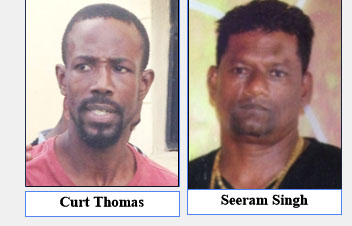When the trial of Curt Thomas continued yesterday, Police Inspector Andre Grant admitted that there were deficiencies in the conduct of an identification (ID) parade at which the accused was pointed out, but said it was nonetheless fair since Thomas had been positively identified.
Thomas is currently on trial before Justice Navindra Singh and a 12-member jury at the High Court in Georgetown.
He is accused of murdering Parika fuel dealer Seeram Singh, during a robbery on the night of Saturday April 30th, 2016 at Parika Outfall, East Bank Essequibo.
Taking the stand yesterday, Grant was extensively grilled by defence attorney Lyndon Amsterdam, with whom he agreed during hours of cross-examination, that the ID parade which he (Grant) conducted breached standard police operating procedures.
Amsterdam called into question the integrity of the parade, contending that in contravention of requirements needed for ensuring a fair process, the ages, ethnicity, general social standing and clothing of the other men placed on the parade, were not similar to that of the accused.
He noted, too, that the position of the persons placed on the parade—in terms of where they stood and even the minimum number of persons required for a parade were all procedures not followed.
The Inspector agreed with counsel that these were all deficiencies in the manner in which the parade was conducted, but was adamant that it was nonetheless fair since, “the accused was positively identified as the suspect who robbed, shot and killed Singh.”
The lawyer then sought to enquire from Grant whether it was his view that once a person is positively identified, the procedure required for the conduct of a fair parade would then be rendered unimportant.
In response, Grant said, “Once the person is identified in the correct way;” though he did not say what would constitute the correct way.
Also taking the stand yesterday was Inspector Lallbachand Dial who spoke of swabbing the hands and nostrils of the accused for gunpowder residue and thereafter placing the samples to air-dry before handing it over to the analyst for testing.
He said he had placed the items to be dried at room temperature at the Leonora Police Station.
Under cross-examination, Dial agreed with Amsterdam that in order to avoid contamination best-practices would require that the hands of a suspect be placed in some sort of protective wear prior to swabbing, but the witness admitted that this was not done.
When asked, he told counsel that it was possible through cross-contamination, for gunpowder residue to get from one person’s hand to another. He said that while he could not say exactly how this can happen; he knows that it is possible.
He also told Amsterdam when asked, that it was possible for such residue to be transferred from a surface to a person and vice versa. He said, too, that it was quite possible for such a transfer to happen if a policeman who had fired a gun and had residue on his hand then touched someone else’s hand.
Dial, however, was keen to point out that he knew of no gun being fired by any policeman at the Leonora Police Station or anywhere else at the time the deceased was shot and killed.
Amsterdam also questioned Dial, who had said he visited the scene, as to if he knew whether the scene may have been contaminated by the crowd which had gathered by the time he arrived there.
Dial said he could not say but confirmed when counsel asked, that the scene was not cordoned off.
Also testifying yesterday was Police Corporal Krishnadat Singh who recalled accompanying Thomas to his home from where he said retrieved several pieces of clothing which he (Thomas) wore on the day in question and the following day.
Singh said that the items were handed over to the analyst to be tested for gun-powder residue.
When asked, he told Amsterdam that he did not search the house for any gun or gold chain—the latter of which he said the deceased was robbed.
Singh agreed with counsel that it would have strengthened the state’s case if a search of Thomas’ home had unearthed a gun or the gold chain.
He, however, said that he had been given specific instructions from his superiors to only retrieve clothing, and with the help of the accused himself, that was exactly what, and all that he did.
Amsterdam enquired from Singh whether having not found a gun and chain at the home of the accused weakened the police’s case. The corporal answered in the affirmative.
The witness was unable to produce the items to the court stating that they could not be found when he went to uplift them yesterday from the Leonora Police Station where they had been lodged.
When asked, Singh had told Amsterdam that though evidence bags are required to be sealed, the bags in which he had placed the pieces of clothing had not been sealed.
Responding to re-examination questions from Prosecutor Tuanna Hardy, the witness explained that he was unable to seal the bags since the subordinate officer-in-charge of the Parika Station where he had first taken the items could not be found to provide the seals.
Given the importance of ensuring the chain-of-custody of the items remained intact, however, Singh said that he personally kept the items until he was able to lodge then at the Leonora Police Station the day after he retrieved the items.
He said they were lodged there until he testified at the preliminary inquiry and returned them after. When he went to uplift them from the Leonora station yesterday ahead of testifying, however, Singh said they could not be found.
Also testifying yesterday was ballistics expert—retired Inspector of Police Eon Jackson who recalled receiving from investigators in the matter for analysis, a .32 round of ammunition and two matching casings.
He confirmed that the components had been discharged from a .32 pistol.
The trial continues this morning at 9.





